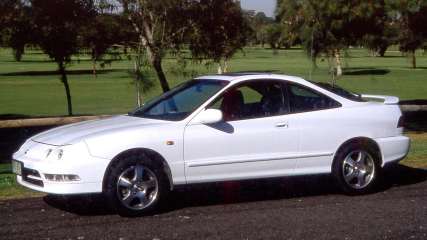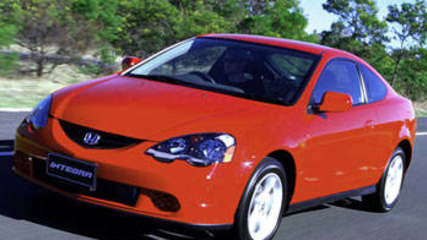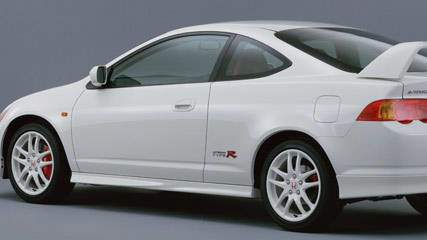Honda Integra 2001 Review
By Paul Gover · 23 Oct 2001
The gang of high-performance sports cars has never been as affordable, or as good, as it is today. No longer do you need to mortgage the house to get a seriously quick piece of machinery that is not that far behind a Porsche in terms of performance.The sub-$50,000 sports car clan is booming, with everything from show pony tiny tots to heart thumping muscle cars and summer-loving convertibles to race-bred pocket rockets. The tarmac-tearing Impreza WRX has been a stunning success for Subaru with its turbo-charged engine, four-wheel-drive transmission and relatively affordable pricetag.But there is a heap of new hero cars challenging the ``Rex'' for the bang-for-your-bucks mantle. They include the Nissan 200SX coupe, Renault Clio Sport hot hatch and even the latest versions of the V8-powered Holden Commodore SS and Falcon XR8. But there is one contender that claims it offers real race-car pedigree -- Honda's new Integra Type R.Honda says the basic structure is stronger and stiffer than the previous, which has allowed the suspension engineers to further improve the car's road-holding ability.DrivetrainThe other major change in the 2002 model is its drivetrain. Honda has built a completely new engine for the Integra range, with its capacity increasing from 1.8 litres to 2.0 litres. The engine is also the first to be sold in Australia with Honda's new-generation i-VTEC variable valve timing system, which continually adjusts the camshaft timing to provide seamless performance while also reducing fuel consumption and harmful exhaust emissions.The Type R version puts out an impressive 147kW of power -- almost as much as the 3.8-litre V6 in the Holden Commodore -- but it only manages 191Nm of torque -- about two-thirds of what the Commodore engine pumps out. As you would expect from a small-capacity, high-performance engine, both of the maximum figures come in at high revs, with peak power achieved at 7400 revs and maximum torque at 6000 revs.The engine is hooked up to an all- new, close-ratio, six-speed manual gearbox that, despite the extra cog, is actually shorter and weighs the same as the five-speed box in the previous model.Appearance and fit-outInside the cabin, the Type R has hip-hugging Recaro race seats, a Momo steering wheel and aluminium gear lever and pedals. There is also a CD sound system, electric windows and mirrors, remote central locking and a race-style cockpit with red-lit instruments.The standard Type R misses out on air conditioning to save extra weight, but it is offered as a $2000 option. Safety-wise, the car comes with dual front airbags and anti-lock brakes.DrivingThis new Integra is a slow burn. At first it looks a little chunky and drives a little clunky, without the instant hit of the first Type R. Even the cockpit is more subdued, with the brilliant Recaro buckets in the new car toned down and the bold white-faced dials have given way to a new silver spread -- or red after dark -- that is reflected in a spacy look for all the dashboard equipment.Some stuff has definitely been carried over, but it's not all good. The grippy Bridgestone RE030s are still far too noisy, steering is heavy and hard work in turns and the engine is not good below 4000 revs. But just wait a while. And take time and kilometres to enjoy the car.It starts with a much more rigid body, which should make the car more livable, and continues through concentrated efforts to cut the noise in the cabin and boost everything from the fuel economy to sales. The new body is bigger, more refined, with a bigger boot and a bit more space in the front of the cabin.The back seat is still tight, especially for headroom, but the switch has even brought much better new headlamps. The basics of the car are still the same, with the action all built around the rev-happy 147kW engine in the nose. It thrives on revs when you are in the mood, but still has enough response to be enjoyable -- and easy on fuel -- at well below the redline. The six-speed manual box is even better, and attention to the change means it now rivals the original Mazda MX-5 for slick shifts.The suspension is much more compliant than before, really handling bumps and blemishes well, in sharp contrast to the buck-and-bounce ride of the old Type R. It still has brilliant cornering grip, though too much throttle will push the front tyres wide in slow turns, but it will not loosen your dental work or mis-track the CD player.The Type R's back end feels more planted as well, which means it just follows the front in all conditions. This is a car that can be hussled along at seriously swift speeds, without getting into trouble or having to work too hard.It is not all good news -- there were worrying signs of a quality slip in the test car. Some of the dash plastic looked cheap, there were a couple of general squeaks, the driver's seat slipped on its rails and there was a noisy tizz from plastic trim around the back window.The latest Civic also shows signs of quality shortcuts, so we hope it's not a general trend at Honda. Even so, it's easy to forget the tizz when the tacho is racing towards 6000 revs and the Type R is heading for the enjoyment zone that makes it one of the best fun cars on the road.The bottom lineA rip-snorting sports hatch that is a lot easier to live with than the previous model.HONDA INTEGRA Type R Price as tested: $45,990Engine: 2-litre, four-cylinder with overhead camshafts and fuel injectionPower: 147kW at 7400revsTorque: 192Nm at 6000revsTransmission: Six-speed manual, front-wheel driveBody: Three-door hatchbackDimensions: Length: 4400mm, width: 1725mm, height: 1400mm, wheelbase: 2570mm, tracks: 1485mm/1485mm front/rearWeight: 1160kgFuel Tank: 50 litresFuel Consumption: 8.9 litres/100km average on testSteering: Power-assisted rack-and-pinionSuspension: Fully independent with front struts and double wishbone rear with anti-roll barsBrakes: Four-wheel anti-skid discsWheels: 6.5x16 alloysTyres: 205/55 R16Warranty: Three years/100,000km





